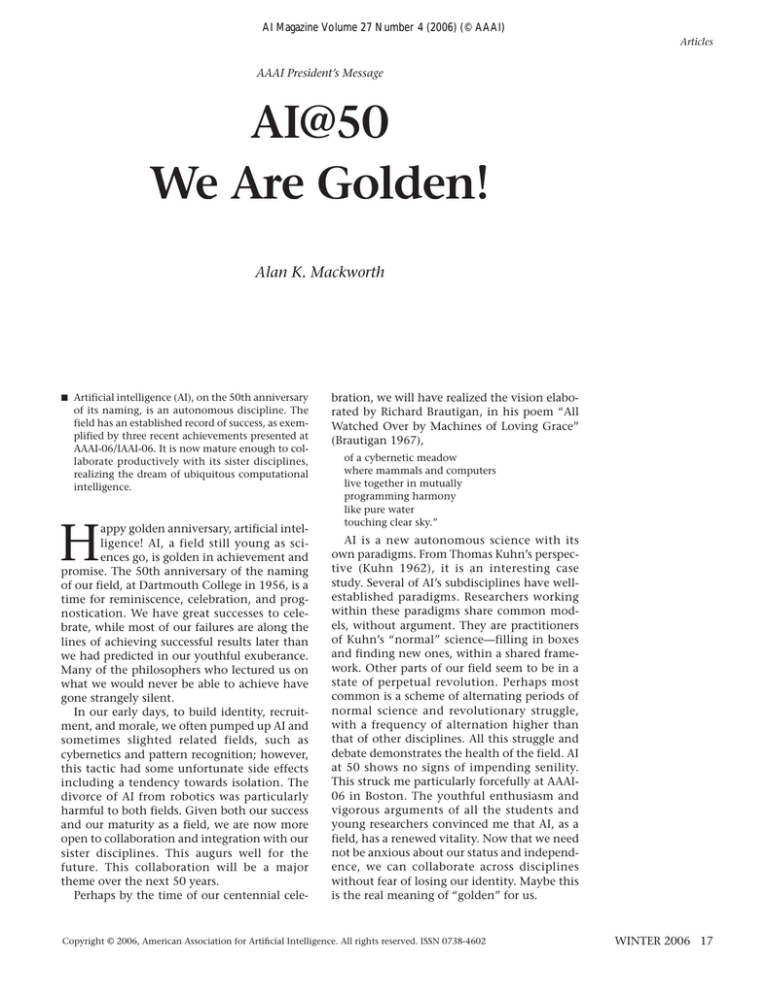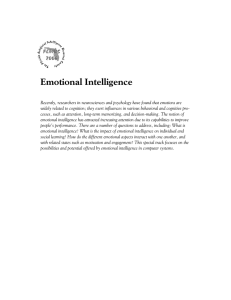
AI Magazine Volume 27 Number 4 (2006) (© AAAI)
Articles
AAAI President’s Message
AI@50
We Are Golden!
Alan K. Mackworth
■ Artificial intelligence (AI), on the 50th anniversary
of its naming, is an autonomous discipline. The
field has an established record of success, as exemplified by three recent achievements presented at
AAAI-06/IAAI-06. It is now mature enough to collaborate productively with its sister disciplines,
realizing the dream of ubiquitous computational
intelligence.
H
appy golden anniversary, artificial intelligence! AI, a field still young as sciences go, is golden in achievement and
promise. The 50th anniversary of the naming
of our field, at Dartmouth College in 1956, is a
time for reminiscence, celebration, and prognostication. We have great successes to celebrate, while most of our failures are along the
lines of achieving successful results later than
we had predicted in our youthful exuberance.
Many of the philosophers who lectured us on
what we would never be able to achieve have
gone strangely silent.
In our early days, to build identity, recruitment, and morale, we often pumped up AI and
sometimes slighted related fields, such as
cybernetics and pattern recognition; however,
this tactic had some unfortunate side effects
including a tendency towards isolation. The
divorce of AI from robotics was particularly
harmful to both fields. Given both our success
and our maturity as a field, we are now more
open to collaboration and integration with our
sister disciplines. This augurs well for the
future. This collaboration will be a major
theme over the next 50 years.
Perhaps by the time of our centennial cele-
bration, we will have realized the vision elaborated by Richard Brautigan, in his poem “All
Watched Over by Machines of Loving Grace”
(Brautigan 1967),
of a cybernetic meadow
where mammals and computers
live together in mutually
programming harmony
like pure water
touching clear sky.”
AI is a new autonomous science with its
own paradigms. From Thomas Kuhn’s perspective (Kuhn 1962), it is an interesting case
study. Several of AI’s subdisciplines have wellestablished paradigms. Researchers working
within these paradigms share common models, without argument. They are practitioners
of Kuhn’s “normal” science—filling in boxes
and finding new ones, within a shared framework. Other parts of our field seem to be in a
state of perpetual revolution. Perhaps most
common is a scheme of alternating periods of
normal science and revolutionary struggle,
with a frequency of alternation higher than
that of other disciplines. All this struggle and
debate demonstrates the health of the field. AI
at 50 shows no signs of impending senility.
This struck me particularly forcefully at AAAI06 in Boston. The youthful enthusiasm and
vigorous arguments of all the students and
young researchers convinced me that AI, as a
field, has a renewed vitality. Now that we need
not be anxious about our status and independence, we can collaborate across disciplines
without fear of losing our identity. Maybe this
is the real meaning of “golden” for us.
Copyright © 2006, American Association for Artificial Intelligence. All rights reserved. ISSN 0738-4602
WINTER 2006 17
Articles
had hoped: no need yet for Asimov’s Laws of
Robotics, alas. However, the Stanford team’s
work, both theoretical and practical, shows the
way forward to building significant robotics
technologies, such as intelligent cars and assistive robots for the disabled and elderly. This is
an area of huge potential for AI and robotics
researchers.
Third, Tuomas Sandholm gave an exciting
IAAI-06 talk about his work on “expressive
commerce” at CombineNet, where he and his
team have demonstrated the enormous gains
achievable with a synthesis of approaches from
operations research, AI, constraint programming, and auction theory in e-commerce applications in satisfying commercial procurement
sourcing and logistics requirements (Sandholm
2006). This work has already had a big impact,
but its future impact will undoubtedly be
greater in a global economy.
Each of these success stories demonstrates
the coming theme of ubiquitous computational intelligence. Each also demonstrates the
leverage gained by combining AI theory and
practice with approaches from our sister disciplines.
So, AI at 50, relax and celebrate your golden
anniversary. Your future, ubiquitous computational intelligence, is even brighter than your
past!
References
One theme common in computer science is
ubiquitous computing. I believe that AI has the
potential to transform that theme to ubiquitous
computational intelligence. Let me give you three
examples of the emerging theme of ubiquitous
computational intelligence, as illustrated by
the talks of three speakers at AAAI-06/IAAI-06.
First, Tim Berners-Lee was the keynote speaker at AAAI-06. The web has transformed the
global society, and AI already plays a significant role in that transformation. The synergy
between the semantic web and AI technologies
will further that transformation.
Second, Sebastian Thrun and the Stanford
Racing Team designed and built Stanley, an
autonomous vehicle. Thrun’s invited talk at
IAAI-06 documented the team’s achievement
in winning the DARPA Grand Challenge, a
major breakthrough for intelligent robotics
(see Thrun’s article on this topic elsewhere in
this issue—ed.). The science behind this victory
integrated robotics, control, vision, and online
AI. Like the web, robotics is another transformational technology. Sadly, the promise of
robotics has not been fulfilled as rapidly as we
18
AI MAGAZINE
Brautigan, R. 1967. All Watched Over by Machines of
Loving Grace. In All Watched Over by Machines of Loving Grace. San Francisco: The Communication Company. Reprinted in The Pill Versus the Springhill Mine
Disaster (San Francisco: Four Seasons Foundation,
1968).
Kuhn, T. S. The Structure of Scientific Revolutions.
Chicago: University of Chicago Press, 1962.
Sandholm, T. 2006. Expressive Commerce and Its
Application to Sourcing. In Proceedings of the TwentyFirst National Conference on Artificial Intelligence,
1736–1743. Menlo Park, CA: AAAI Press.
Alan K. Mackworth is a professor
of computer science, Canada
Research Chair in Artificial Intelligence, and the founding director
of the Laboratory for Computational Intelligence at the University of British Columbia. He received a B.A.Sc. (Toronto, 1966),
A.M. (Harvard, 1967), and D.Phil.
(Sussex, 1974). He has worked primarily on constraint-based artificial intelligence with applications
in vision, constraint satisfaction, robot soccer, and
constraint-based agents. He has served as chair of the
IJCAI Board of Trustees and as president of the Canadian Society for Computational Studies of Intelligence; he is now president of AAAI.


